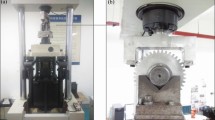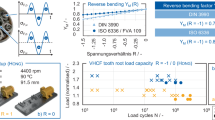Abstract
Gear geometry plays a significant role in deciding the tooth deflection, magnitude of stress induced and stress distribution. Accurate evaluation of the stress state and distribution of stresses at the tooth root requires application of experimental methods to determine, such as electric resistance wire strain gauges, or photoelastic gauges, etc. These experimental methods are especially complicated, expensive, and laborious. Therefore, they are applied mainly in special cases. In the recent years, the methods of probabilistic design have been commonly accepted in the design of mechanical components and systems to assist the designer in making decisions on the best balanced design with respect to several design criteria. In probabilistic design, it is common to use parametric statistical models to calculate the probability of failure obtained from the Stress–Strength Interference (SSI) theory, which more nearly models the true situation. This paper discusses the application of the SSI theory that has been used to support the detailed gear design as part of the “Design for Reliability” approach to evaluate the tooth-root strength with finite element method-based verification. The SSI theory is formulated to predict the effect of the root fillet generated by rack or hob tool with and without protuberance on the gear system reliability. The results indicate the high fillet root stresses and gear tooth deflection in gears with the lowest tip radius of the generating tool.













Similar content being viewed by others
References
Vlahinos, A., Kelkar, S., Reh, S., Secaur, R., Pliz, S.: Reliability based optimization within the CAD environment. http://www.aes.nu/publications/2002-ReliabilityBasedOptimiz-bmx-ANSYS.pdf (2002)
Cooper, G., Thompson, G.: Concept design and reliability. Acta Polytechnica, vol. 42, No. 2. Czech Technical university publishing house, Prague (2002)
He, X., Oyadiji, S.O.: A study of practical reliability estimation method for a gear reduction unit. In: IEEE SMC’99 Conference Proceedings, Vol. 1, pp. 948–953 (1999)
Du, X., Chen, W.: Sequential optimization and reliability assessment method for efficient probabilistic design. J. Mech. Des 126(2), 225–233 (2004)
Townsend, D.P.: Dudley’s Gear Handbook. McGraw-Hill, New York (1992)
Kawalec, A., Wiktor, J., Ceglarek, D.: Comparative analysis of tooth-root strength using ISO and AGMA standards in spur and helical gears with FEM-based verification. J. Mech. Des. 128, 1141–1158 (2006)
Kapelevich, A.L., McNamara, T.M.: Direct gear design for automotive applications. SAE World Congress & Exhibition, Detroit, MI, USA (2005)
Bertsche, B.: Reliability in automotive and mechanical engineering: determination of component and system reliability. Springer, Berlin (2010). ISBN 978-3-642-07049-5
Kuczera, R.C., Mourelatos, Z.P.: On estimating the reliability of multiple failure region problems using approximate metamodels. J. Mech. Des. 131(12), 1–11 (2009)
Haugen, E.G.: Probabilistic mechanical design. Wiley, New York (1980)
Martin, P.: A review of mechanical reliability. In: Proceedings of the Institution of Mechanical Engineers, Part E, vol. 212, pp. 281–287 (1998)
Aziz, E., Chassapis, C.: Knowledge-based geometry generation for spur and helical gears. Concurr. Eng. Res. Appl. J. 10(3), 251–261 (2002)
Aziz, E., Chassapis, C.: An intelligent design system for agile design and manufacturing of mechanical transmission systems. In: The 9th International ASME Power Transmission and Gearing Conference, pp. 397–408. Chicago, Illinois, USA (2003)
Xiaogen, S., Houser, D.R.: Characteristics of trochoids and their application to determining gear teeth fillet shapes. Mechanism Mach Theory 35(2), 291–304 (2000)
Math, V.B., Chand, S.: An approach to the determination of spur gear tooth root fillet. J. Mech. Des. 126, 336–340 (2004)
AGMA 930–A05.: Calculated Bending Load Capacity of Powder Metallurgy (P/M) External Spur Gears. American Gear Manufacturers Association, Alexandria (2005)
AGMA Information Sheet 908–B89: Geometry Factors for Determining the Pitting Resistance and Bending Strength of Spur, Helical and Herringbone Gear Teeth. American Gear Manufacturers Association, Alexandria (1989)
Stoker, K., Chaudhuri, A., Kim, N.H.: Safety of spur gear design under non-ideal conditions with uncertainty. In: Proceedings of the ASME 2010 IDETC/CIE, Montreal, Quebec, Canada, pp. 1–11 (2010)
Dolan, T.J., Broghame, E.L.: A Photoelastic study of stresses in gear tooth fillets. Engineering Experiment Station Bulletin Series No. 335, University of Illinois, Urbana-Champaign (1942)
Minitab Statistical Software. http://www.minitab.com/en-US/
Author information
Authors and Affiliations
Corresponding author
Rights and permissions
About this article
Cite this article
Aziz, ES., Chassapis, C. Comparative analysis of tooth-root strength using stress–strength interference (SSI) theory with FEM-based verification. Int J Interact Des Manuf 8, 159–170 (2014). https://doi.org/10.1007/s12008-014-0218-3
Received:
Accepted:
Published:
Issue Date:
DOI: https://doi.org/10.1007/s12008-014-0218-3




